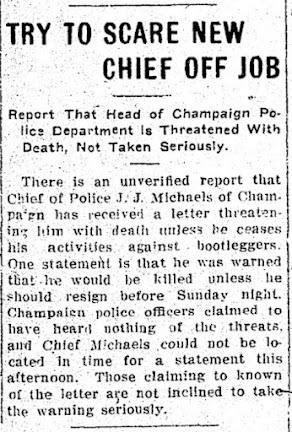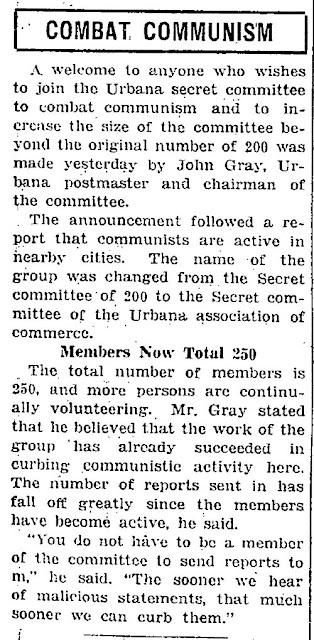 |
| This illustration in the 7/15/1944 Gaffney Ledger doesn't clearly indicate who the likely serial killer is, let alone her targets in the Black community. |
Local historians and history buffs helped shed some light for me on a crazy story involving murder, mortgage scams, and true-crime mysteries in segregated 1920s Champaign. The characters include a prominent white widow and real estate business she's running with a former Champaign Chief of Police targeting the local Black community. Multiple murders, suspicious deaths, poisonings, and maybe even a woman serial killer emerged out of the local coverage. And of course, the Klan pops up throughout the story as a tool for intimidation, within local law enforcement, and even the State's Attorney prosecuting the case.
Jump To:
- Stumbling Over a Cross Burning Into a Murder Mystery
- Morgan Knox Murder
- Anna Carmody Murder
- Jack Michaels Suicide
- Unrelated Bandits and Shootouts?
- Wells and Other Poisonings
- Other Coverage and Conclusions
Stumbling Over a Cross Burning Into a Murder Mystery
I had stumbled upon on yet another old Champaign News-Gazette story about a cross burning in my Klan research in Champaign County. This time it was in front of the home of the Black coroner working on another local case. From the 8/11/1926 News-Gazette:
One of the first questions I often get is about the Black coroner. This was not the elected coroner, who at the time was W. J. Strode, a white man who was in charge overall of the coroner duties. The concept of "separate but equal" and enforcement of the color line was complicated in the North. In many public offices and other situations there were normal matters and procedures of the white community. Matters outside of that white community were generally treated as special circumstances. For example, when a dead Black body was found, a Black undertaker may be given responsibility over something deemed a matter of the Black community. The jury for a death inquest like that may be comprised only of Black community members. This was often phased as matters "within their race."
The mention of a previous cross burning put this on my list of items to follow up on. It turns out J. J. Michaels was not another Black person being threatened by local Klan members in yet another "unauthorized" cross burning. He was a white former Police Chief for the City of Champaign (and failed Champaign County Sheriff candidate in 1914). Earlier Urbana Daily Courier articles paint him as an early enforcer of liquor restrictions before federal prohibition, to local annoyance and threats. From the Courier on 8/15 and 10/24/1914:
It may difficult to find out who exactly targeted Michaels for a cross burning or why. The local Klan leadership disavowed "unauthorized" cross burnings beyond the ceremonial usage at events. That doesn't appear to have meant much to their members or even the leadership itself, at least beyond their concern for bad publicity. What we do know is that within a month of Morgan Knox's body being found on a desolate country road, there would be a pile of new dead bodies, and links to many previous bodies and shootings.
Morgan Knox Murder
Here's the 7/22/1926 front page and article on the discovery of the Knox body, riddled with bullets:
The investigation appears to have begun with a bit more intrigue than a more straightforward crime scene, which gives us an opportunity to see who the players were in the legal system and their methods. It starts off with "Deputy Sheriffs Ed Ulitsch and Walter Fulton went to the scene of the crime to begin an investigation." Ed Ulitsch was Klan member #1867. Walter Fulton appears likely to have been member #2749 in the surviving Klan financial records and eliminating other possibilities. The Sheriff himself being an open proponent and apologist for the Klan since his raiding days with S. Glenn Young set the context of the investigation.
It should be remembered, that Gray and the official Klan position generally viewed themselves without prejudice or animus against non-white people, but also believed that white supremacy was a reality and natural state of things. Of course, to their targets and those they deemed inferior (or at least in a different caste than the ruling white race), this distinction sounded no different than modern rationalizations for white supremacist views and systems. From the Courier coverage of an early local Klan meeting on 1/31/1923:
"We have no enmity for the Jew, the negro, or the Catholic, but we claim the right of American citizens to bar whoever we choose from our organization."
And then, without viewing this as contradictory a couple paragraphs later, Klan Reverend McMahan added:
"The klan believes in white supremacy, in the Christian religion, in the constitution of the United States, in upholding pure womanhood, and in a single standard of morals for both men and women."
It is in that context, the first suspect found himself being grilled on the death of the man he was last seen with. The 7/23/1926 News-Gazette introduces the plight of a Black man named Zack Fletcher:
Within a couple days the News-Gazette would report that Fletcher was now being held to "prove his innocence." More details would also emerge of an unusual insurance arrangement the victim had with Anna Carmody, a local real estate businesswoman. From the 7/25/1926 News-Gazette:
Fletcher would be held as a suspect, without actually being under arrest, for weeks throughout the investigation. From the 8/15/1926 News-Gazette:
During those first few days, the Sheriff also focused his attention on the local Black church of which there had been an ongoing disagreement involving the victim. The intervention coverage pointed out concerns about further violence, a lot of paternalistic themes, and even the desire to appoint white mediators to help settle a dispute within the Black church. From the 7/25 and 7/26/1926 News-Gazette:
The article lays out the new twists of the case and some additional background. This included the vehicle Allen (Jones) Thomas used to dump Morgan Knox's body being purchased by Mrs. Carmody and her business partner (former Champaign Police Chief J. J. Michaels). Morgan Knox is noted to have moved to Champaign from Urbana a couple years before after receiving warnings from the local Ku Klux Klan. The prolific nature of the Klan in the background throughout all of this would become relevant in other aspects of Carmody's schemes, though the Klan itself would not be implicated in any of the deaths. The full article in snippets from the same 7/30/1926 News-Gazette:
The supposed suicide of Anna Carmody would itself become the subject of investigation, with the gun she allegedly used having belonged to her business partner and former police chief Michaels. The 8/1/1926 News-Gazette coverage included a rash of seemingly unrelated violent deaths in the area as well:
A few more days of rumors and intrigue and even a former chauffeur for Mrs. Carmody (referred to as Springer) being held for questioning didn't amount to much until the 8/4/1926 News-Gazette noted the connections between Carmody and other local deaths. These deaths including one the year before involving Allen Thomas (suspect in the Knox killing) as well as a recent death of Mrs. Wells, who had been shot by her husband:
The coroner's inquest into Carmody's alleged suicide turned into a public spectacle and a full blown murder trial of sorts. Anna Carmody's business partner and former police chief J. J. "Jake" Michaels would be caught lying, changing his story, and witnesses down to a 14 year old at the Country Club who saw him chasing down Carmody in her final moments.
Jake Michaels Suicide
The holes in J. J. Michaels story and the literal holes in his car (allegedly from Carmody test firing the gun in preparation for her suicide) became evidence of an obvious life and death struggle over the gun between the two. Michaels would eventually chase Mrs. Carmody down and shoot her in the head (illustrated at the top of this page). Michaels would kill himself rather than face an actual murder trial. From the 8/8/1926 News-Gazette:
Unrelated Bandits and Shootout?
The attempted robbery of a local clothing store and the resulting manhunt for the bandits appeared unrelated to the Triangular Deaths mystery, except for rumors that the bandit who died in the shootout, Norvy Jackson Simpson was a half-brother of one of the Knox murder suspects (Carmody's chauffer, Springer). There was news coverage of the gun battle that peppered a house with a baby in it with bullets and ended with a poetic and gory description of Simpson meeting his end in a lily patch. From the 8/10/1926 News-Gazette:
The mother of Springer would deny the relation in the next day's coverage of the bandit's death. The same edition of the News-Gazette would have an article (also mentioned earlier) about the recent cross burnings targeting J. J. Michaels before his death and the Black coroner C. H. Mathews. From the 8/11/1926 News-Gazette:
The News-Gazette would have a special page dedicated to overviewing the Triangular Deaths and the remaining surviving suspect, Allen Thomas, in their 8/15/1926 edition. It would also include a list of violent local deaths in July and August on the same page (click to enlarge):
In that same paper the News-Gazette would write an editorial decrying the recent cross burnings, reiterating previous denials of the local Klan leadership. In absolving Klan responsibility they also quoted the openly pro-Klan Sheriff as saying, "the Klan has too much sense to do such a thing."
Wells Murder and Other Poisonings
The Mary Wells death had been linked to Mrs. Carmody in earlier rumors (above in the 8/4/1926 News-Gazette). The initial reporting had the woman dying of blood poisoning from a bullet wound inflicted by her husband. The initial inquest into the Wells death appeared to leave no doubt as to the husband's culpability. From the 7/7 and 7/8/1926 Courier:
A few months later the States Attorney would confirm the rumors and present evidence that Anna Carmody poisoned Mrs. Wells during frequent visits to her hospital bed. It was shown that the arsenic introduced to her by Carmody was the cause of her death. Mr. Wells was initially facing a murder trial, prior to the evidence of arsenic poisoning. From the 11/9 and 11/14/1926 Daily Illini:
Other Coverage and Conclusions:
In Tom Kacich's book Hot Type, the prosecutor expressed his belief that Carmody had poisoned other Black members of the community beyond just Knox and Wells as part of her real estate schemes:
Was Anna Carmody, a white widow and real estate scam artist, a serial killer of local Black members of the Champaign-Urbana community? The local States Attorney at the time seemed convinced, whether one's standard is a minimum of three or four murders for the modern definition. Proving that with any more certainty might require literal digging as opposed to merely digging up old microfilm.
The Kacich book excerpts also indicate that Carmody used the threat of the Ku Klux Klan in the area to intimidate Thomas into cooperating with their crimes. Just another strange aspect of a well known Klan presence locally that had members doing the police work and criminals utilizing the fear it generated. In the strange case of Anna Carmody and her victims in the Black community, the Klan was ever present beyond the cross burnings.
The illustration I snipped at the top of this post comes from an overview of the case in the 7/15/1944 Gaffney Ledger of Gaffney, South Carolina. It was brought to my attention by local historian T. J. Blakeman who has covered this story as part of his historic walking tours of local vice and crime in the prohibition era. (click to enlarge)
It is an incredible story, in and of itself. But even this fairly sensationalized true-crime story doesn't do the full crazy story justice.










































No comments:
Post a Comment